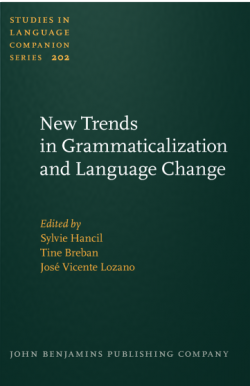New Trends in Grammaticalization and Language Change
N° ISBN : 978-90-272-0163-8
Editeur : John Benjamins Publishing Company
The chapters in this volume present a state of the art of grammaticalization research in the 2010s. They are concerned with the application of new models, such as constructionalization, the ongoing debate about the status and modelling of the development of discourse markers, and reveal a renewed interest in the typological application of grammaticalization and in the cognitive motivations for unidirectionality. The contributors consider data from a wide range of languages, including several that have not or marginally been looked at in terms of grammaticalization: Chinese, Dutch, (varieties of) English, French, German, Japanese, Maltese, Old Saxon, Spanish, and languages of the South Caucasian and Zhuang Tai-Kadai families. The chapters range from theoretical discussions to fine-grained analyses of new historical and comparative language data. This volume will be of interest to linguists studying morphosyntactic changes in a range of languages, and in particular to those interested in models for grammatical change.
Edited by Sylvie Hancil (University of Rouen Normandy), Tine Breban (The University of Manchester) and José Vicente Lozano (University of Rouen Normandy)
TABLE OF CONTENTS
- Tine Breban and Sylvie Hancil, Introduction: Grammaticalization in the 2010s – A dialogue between the old and the new
Part 1. General issues
- Bernd Heine, Are there two different ways of approaching grammaticalization?
- Ekkehard König and Jingying Li, Functional similarity despite geographical distance: On the grammaticalization of German mal and Chinese yíxià
- Olga Fischer, Analogy: Its role in language learning, categorization, and in models of language change such as grammaticalization and constructionalization
- Yang Huang and Fuxiang Wu, Central Southern Guangxi as a grammaticalization area
- Diana M. Lewis, Grammaticalizing connectives in English and discourse information structure
Part 2. Case studies
The noun phrase
- Ophelie Gandon, The grammaticalization of interrogative pronouns into relative pronouns in South-Caucasian languages: Internal development or replica?
The verbal phrase
- Susana Rodríguez Rosique, From time to surprise: The case of será posible in Spanish
- Naoaki Wada, C-gravitation and the grammaticalization degree of “present progressives” in English, French, and Dutch
- Maris Camilleri, The avertive and proximative grams in Maltese using the auxiliary għodd
Discourse markers
- Elise Louviot, Pragmatic uses of nu in Old Saxon and Old English
- Sylvie Hancil, (Inter)subjectification and paradigmaticization: The case study of the final particle but
- Yueh Hsin Kuo, The development of three classifiers into degree modifier constructions in Chinese
- Reijirou Shibasaki, From the inside to the outside of the sentence: Forming a larger discourse unit with jijitsu ‘fact’ in Japanese
- Bing Zhu and Kaoru Horie, The development of the Chinese scalar additive coordinators derived from prohibitives: A constructionist perspective
- Mitsuko Narita Izutsu and Katsunobu Izutsu, Cross-varietal diversity in constructional entrenchment: The final-tag construction in Irish and American English
Subject index






